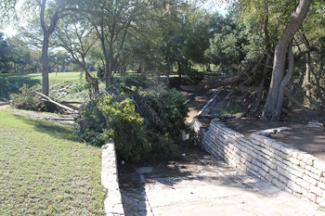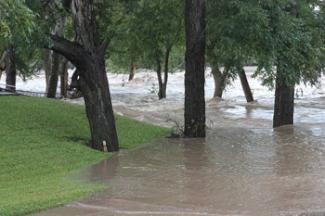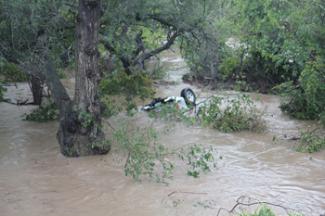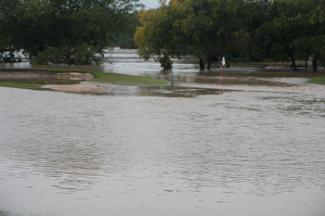Featured Golf News
Austin's Onion Creek Club Fights Back after Devastating Flash Floods
Most of the low-lying holes at Austin's famed Onion Creek Club were destroyed on October 30th and 31st by a series of flash floods that swelled the normally docile creek from which the club takes its name to more than 40 feet above flood-stage level.

This Was the No. 3 Green on
Onion Creek's Original course
But the club's membership and staff, exhibiting a never-say-die spirit and tireless work ethic, already have nine holes back in play and vow to have 18 of the course's 27 holes repaired and cleaned up by the end of the year.
Onion Creek Club, the original home of the Legends of Golf tournament and site of the founding of the Senior (now Champions) Tour, will celebrate its 40th anniversary in 2014. For 11 years, beginning in 1978, Onion Creek Club conducted the celebrated Legends tournament, as the course designed by Jimmy Demaret and founded by legendary Texas amateur Jimmie Connolly in 1974 more than held its own against the great golfers of that period.
An additional nine holes, fashioned by Ben Crenshaw and Bill Coore, were put into play on higher ground in 1996. It's those nine holes that were first playable after the flood. Nine holes from the original course are being repaired now and the club expects them to be open (under "winter golf" conditions) by January 1.

Once the Waters Subsided,
Piles of Debris and Trees were Everywhere.
It will take considerably longer to rebuild the front nine of the original course, which is set in the lowest part of the property.
It's hard to believe or even fathom the devastation to the course and surrounding neighborhood created by the raging waters that, at one point, saw Onion Creek rise 11 feet in 15 minutes. On October 31 (on the morning after 18 inches of rain pelted southeast Austin) the creek's flow rate was 120,000-cubic feet per second. That's nearly double the average flow of Niagara Falls.
Onion Creek crested at the highest it's been in 92 years, and reached dozens of homes in the neighborhood, including a line of houses across the street from the creek and 80 yards across the fairway of the third hole.

Raging Onion Creek Flowed at Twice
the Rate of Niagara Falls
Onion Creek Club's original 18 holes were built on a floodplain of the burgeoning neighborhood some 15 minutes southeast of Austin's downtown sector. The club and community have endured floods in the past; in both 1998 and 2001 the creek overflowed and destroyed parts of the course. But the water had never before damaged the homes and property above the course.
"I was called to the club at about 6:30 in the morning and when I got here the water was over some of the road bridges," said Justin Jafarian, Onion Creek Club's general manager. "Some houses had four feet of water in them and people just didn't know what to do or how that happened."
Preliminary estimates place damages to the course at about $5 million. The club also lost its course-maintenance equipment when the building where it is housed was swamped with four feet of water; to get to that structure, the rising creek had to cross a huge grass berm constructed to keep water away after the 2001 flood.

The Flood Swept a Truck into Onion Creek
After enduring several years of drought conditions, October of 2013 was the wettest October on record in Austin. In fact, a smaller flash flood October 12 ripped up several of the course's greens, knocked down some trees and destroyed all the bunkers on the low-lying holes. When the rains came on the night of October 30, conditions were ripe for a disaster.
As the rain poured in buckets, the water continued to rise and move with alarming speed. A dozen putting surfaces were scraped down to sub-turf level, exposing irrigation pipes and electrical wires. Trees were felled and swept away - a 70-foot-tall oak that once stood to the left of the sixth green was uprooted and rolled down the fairway of the adjacent par-5 seventh, tumbling some 700 yards before becoming lodged against another huge oak.
A cement and shell barrier encased in chicken wire and weighing tons that was built to protect the fourth tee was twisted and rolled like a wet dishrag - but it did its job, the tee remains intact.
A cement dam between the creek and pond that fronts the par-3 11th hole on the original course was breeched and left with a huge sinkhole.

The 15th Green on the Crenshaw Nine
But the amount of water that flowed into the valley that forms the course's signature hole - the downhill par-4 12th, with a drop of 50 feet from tee to fairway - was almost incomprehensible. Looking out from the tee of the par-3 17th, which also sits high above the valley that forms the 12th, all one could see was a lake of water; the 12th green was covered by at least 20 feet of floodwater.
Onion Creek Club, owned and operated by the Dominion Golf Group, has more than 800 members, about half of which enjoy golfing privileges. Jafarian said that about 70 percent of the membership resides in the adjoining neighborhood.
In the aftermath of the disaster, the club was the focal point of a community recovery effort. Local grocery stores provided volunteers to help residents clean up their flooded homes and an area restaurant donated food to feed those affected by the flood and the volunteers.
"Our focus for the first few days was making sure everyone was safe and cared for and that those affected had someplace they could go for help," Jafarian said. "This community pulled together to help their neighbors; we just gave people a central place to come to get the aid that was offered."

The 12th Hole (Foreground)
and the 16th Green Pre-Flood
The club's driving range was available for use just two days after the flood and the golf professionals have been conducting lessons and seminars, trying to make the best out of a bad situation. Members have been granted playing privileges at several area clubs as well as the Dominion Golf Group's sister clubs, two of which (River Place CC and Twin Creeks CC) are in the Austin area.
"We are determined to get back to normalcy as quickly as possible, and the grounds-keeping crew has been working dawn to dusk to clean up the course and get our members back out on the course," said John Ferguson, Onion Creek's director of golf.
Since Demaret, Connally and their pal Bing Crosby first sent a golf ball rocketing down the No. 1 fairway, Onion Creek has held a special place in golf history. Now, another chapter in its memorable book - one of destruction, recovery and the coming together of a membership - has been put to the page.
Steve Habel is a freelance writer contributing Cybergolf news stories, features, equipment and book reviews and personality profiles from his base in Central Texas. He also works as a contributing editor for Horns Illustrated magazine, a publication focusing on University of Texas sports, and is a contributing writer for Golfers' Guide and Golf Oklahoma magazine, Texas Links magazines and Golfers Guide. Habel's main blog (www.shotoverthegreen.blogspot.com) features news on golf and the Longhorns, and another (www.checkinginandplayingthrough.blogspot.com) chronicles his many travels, including playing more than 600 golf courses since 2008. Habel is a member of the Golf Writers Association of America and the Texas Golf Writers Association.
Story Options
 |
Print this Story |
